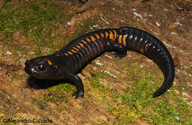|
Isthmura maxima (Parra-Olea, García-París, Papenfuss & Wake, 2005)
Southern Giant Salamander, Salamandra Gigante de Putla | family: Plethodontidae subfamily: Hemidactyliinae genus: Isthmura |
| Species Description: Parra-Olea G, Garcia-Paris M, Papenfuss TJ, Wake DB 2005 Systematics of the Pseudoeurycea bellii (Caudata: Plethodontidae) species complex. Herpetologica 61:145-158 | |
 © 2018 Rafael Alejandro Calzada-Arciniega (1 of 8) |
|
|
|
Description DIAGNOSIS: Isthmura maxima can be distinguished from other members of its genus based on coloration, overall body size, and the proportions of its head and limbs. It possesses a broader head and longer limbs than I. bellii and I. boneti, and it can also be distinguished from I. boneti based on its paired spots (rather than chevrons), lack of shoulder markings, and lack of combined pelvic spot complex. The lack of the shoulder markings and combined pelvic spot complex also distinguishes I. maxima from I. naucampatepetl, along with a broader head and larger overall size. Unlike I. gigantea, I. maxima has no combined spot at the start of its dorsal marks (Parra-Olea et al. 2005). COLORATION: In life, though coloration can be somewhat variable, I. maxima typically has a mostly black body coloration with vivid orange marks arranged in parallel rows down the head, body, and proximal region of the tail. The exact shade of these marks varies by individual. Most collected specimens have had broken occipital spots, but none have possessed scapular spots or a nuchal spot. The dorsum has 10 - 15 pairs of spots, with some unpaired spots interspersed throughout this pattern on some individuals. There is a pair of spots directly over the sacrum that is then followed by a pair of spots on each caudosacral segment. There are no spots at the autonomy plane. The tail has irregular marks up to the tenth caudal segment. The venter is the same color as the dorsum, with occasional lightening around the gular region. Males may also exhibit a lightened area over their mental gland (Parra-Olea et al. 2005). VARIATION: The exact pattern of the orange markings can vary between individuals, both in number of marks and precise location. The intensity of the orange shade is also often different. Males tend to have both a notable mental gland and a longer tail than females (Parra-Olea et al. 2005). Distribution and Habitat Country distribution from AmphibiaWeb's database: Mexico
Isthmura maxima is found at elevations between 750 and 2000 m above sea level (Rocha et al. 2019). The species is found in wet tropical forests and somewhat montane areas, and several specimens have been collected along roads or within agricultural areas. It can usually be found in burrows (Parra-Olea et al. 2005). Life History, Abundance, Activity, and Special Behaviors Larva Trends and Threats Possible reasons for amphibian decline General habitat alteration and loss Comments PHYLOGENETIC RELATIONSHIPS: Bayesian analysis of ultraconserved elements nuclear DNA show that I. maxima and I. boneti are likely sister species in a clade that diverged from the rest of the I. bellii complex (Bryson et al. 2018). The species epithet is presumably a reference to the species’ large body size. Synonyms:
References
Bryson, R.W., Zarza, E., Grummer, J.A., Parra-Olea, G., Flores-Villela, O, Klicka, J., and McCormack, J.E. (2018). “Phylogenomic insights into the diversification of salamanders in the Isthmura bellii group across the Mexican highlands.” Molecular Phylogenetics and Evolution, 125, 78-84. [link] Dubois, A., Raffaelli, J. (2012). ''A new ergotaxonomy of the order Urodela Duméril, 1805 (Amphibia, Batrachia).'' Alytes, 28(3-4), 77-161. [link] IUCN SSC Amphibian Specialist Group. (2016). "Isthmura maxima." The IUCN Red List of Threatened Species 2016: e.T61907A53989368. https://dx.doi.org/10.2305/IUCN.UK.2016-3.RLTS.T61907A53989368.en. Downloaded on 08 October 2020. Parra-Olea, G., Garcia-Paris, M., Papenfuss, T. J. and Wake, D. B. (2005). ''Systematics of the Pseudoeurycea bellii (Caudata: Plethodontidae) species complex.'' Herpetologica, 61, 145-158. Rocha, G., Mata-Silva, V., Mata-González, S., Ramíerez-Bautista, A., Berriozabal-Islas, C., Wilson, L.D. (2019). “Geographic distribution of the endemic salamander Isthmura maxima (Amphibia: Plethodontidae) from southern Mexico.” Herpetology Notes 12, 1231-1233. [link] Originally submitted by: Eden D. Rozing (2022-08-24) Description by: Eden D. Rozing (updated 2022-08-24)
Distribution by: Eden D. Rozing (updated 2022-08-24)
Life history by: Eden D. Rozing (updated 2022-08-24)
Larva by: Eden D. Rozing (updated 2022-08-24)
Trends and threats by: Eden D. Rozing (updated 2022-08-24)
Comments by: Eden D. Rozing (updated 2022-08-24)
Edited by: Ann T. Chang (2022-08-24) Species Account Citation: AmphibiaWeb 2022 Isthmura maxima: Southern Giant Salamander <https://amphibiaweb.org/species/6435> University of California, Berkeley, CA, USA. Accessed May 8, 2025.
Feedback or comments about this page.
Citation: AmphibiaWeb. 2025. <https://amphibiaweb.org> University of California, Berkeley, CA, USA. Accessed 8 May 2025. AmphibiaWeb's policy on data use. |


 Raffaëlli Account
Raffaëlli Account Map of Life
Map of Life